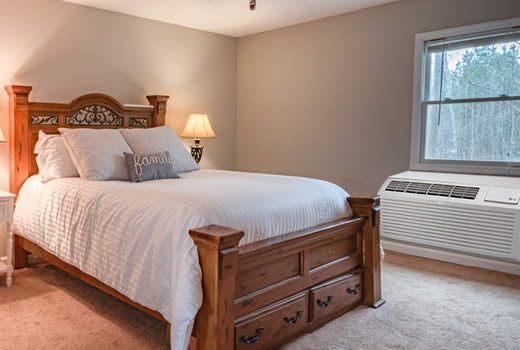What is a PTAC Air Conditioner?
If you're curious to know what is a PTAC air conditioner, I'll explain what the Packaged Terminal Air Conditioner is, how it works and its benefits and drawbacks here.
These coolers are often seen in hotel and motel rooms, hospitals and health centers, offices and a variety of public buildings. They are standalone air conditioning units that often feature a heater function and they can usually be found physically occupying the space below a window.
They are positioned on an outside wall to facilitate easy venting through the wall to the outside. Let's look at these coolers in some more detail.
How Does a PTAC Work?
 PTACs are basically a self-contained heating and air conditioning unit that services an individual room.
PTACs are basically a self-contained heating and air conditioning unit that services an individual room.
They are electrically powered and operate in a similar way to a domestic refrigerator by pumping a refrigerant throughout a circuit of pipes inside the unit to remove heat and humidity from the room and expel it out through a vent in the wall.
In a similar manner to other forms of air conditioning, PTACs remove warm, moist air from the room and replace it with chilled, dried air using a refrigeration process.
To be most effective and to aid venting, PTACs are generally installed beneath a window against the exterior wall. They can also be installed with a metal shield making it possible to install directly into a wall.
They are generally installed in rooms that can be isolated from other areas in a building, as they are not designed to be used for heating or cooling larger areas.
How Does a PTAC Unit Drain?
PTAC units are completely self-contained, doing away with the need for drain piping.
They achieve this by directing all the condensed water taken from the atmosphere to the condenser coil's surface, where it evaporates and is expelled through the wall vent.
How Much Electricity Does a PTAC Use?
Most PTACs run on 210-240 volts, so if installing them in your home you will need to have a separate higher voltage electricity circuit installed alongside your normal 110 volt circuit.
A typical 12,000 BTU unit, such as the LG featured below, can cool a space of up to 600 square feet and use up to 3,500 watts at full power for cooling. For heating, the same unit will use 3,000-3,500 watts. For maximum power for both heating and cooling, it is recommended to use a 30 amp power cord connected to a 240 volt circuit.
The LG unit also employs inverter technology that allows the unit to run at reduced capacity once the set temperature is reached to conserve energy while maintaining the correct temperature.
Do PTAC Units Bring in Fresh Air?
Despite the commonly held belief that PTACs draw in fresh air from outside, the reality is that while some air is drawn in from outside by the fan, they do not fully provide code-required ventilation levels.
This is often caused by the user manually turning off the fan. However, even with the fan running, there is created a greater negative pressure level through the vent door and air filter than is created through the evaporator coil, restricting the intake of outside air.
What PTAC Unit is Recommended?
For larger rooms in homes, offices and other commercial settings up to 700 sq ft, my recommendation is a 12,000 BTU model.
For medium size rooms, a less powerful model is needed and for reference, I have included an example appliance from Friedrich that you might like:
Friedrich ZoneAire Premier
7,200 BTU PTAC with Heat

The high quality Friedrich 7,000 BTU ZoneAire Premier PTAC with heat is currently one of the more popular models on sale... Click to read more
Benefits of PTAC Units
There are some benefits to choosing a PTAC instead of a window AC, a portable AC or a mini-split AC unit. The main benefit is energy economy while in use, as these units are generally designed to run on low power once a set temperature has been reached to maintain that temperature.
Another benefit is that it is an all-year climate solution, being able to cool a room in hot weather and also heat it in cold weather.
Also beneficial is the quieter operation levels when compared to most window and portable units, while most models will also self-evaporate excess moisture and expel it through the wall vent.
Common Problems with PTAC Units
One of the more common problems experienced with PTACs especially in hotel rooms is excessive build-up of moisture inside the room, leading to damp patches and mold growth on walls.
This problem can be avoided by correct installation procedures performed by a professional, certified installer as well as correctly sizing the unit for the size of room to be cooled.
Incorrect installation and lack of attention to regular maintenance schedules can also be to blame, so it is important to have your unit regularly serviced by a professional HVAC engineer.
Conclusion
If your needs for a cooling and heating solution are for an economical yet powerful appliance that can be fixed permanently in a suitable location on an outer wall, you should seriously consider a PTAC.
A packaged terminal air conditioner can be an excellent cooling and heating solution where a window AC is not permitted due to rental agreement rules or unsuitable due to window space limitations.
It only takes up a small amount of space, often located in a position beneath a window where it is out of the way. Yet there can be a lot of heating and cooling power wrapped up inside a relatively small package that will provide you with all-year round comfort for a reasonable outlay and economical on-going running costs.
Last Updated: July 24, 2025
![]()

